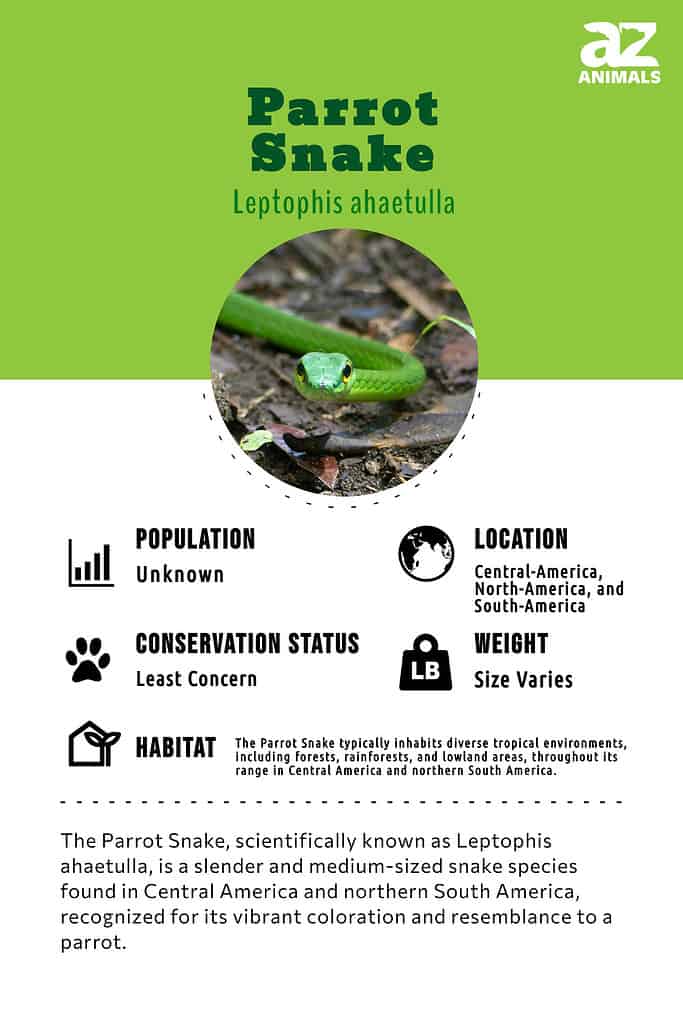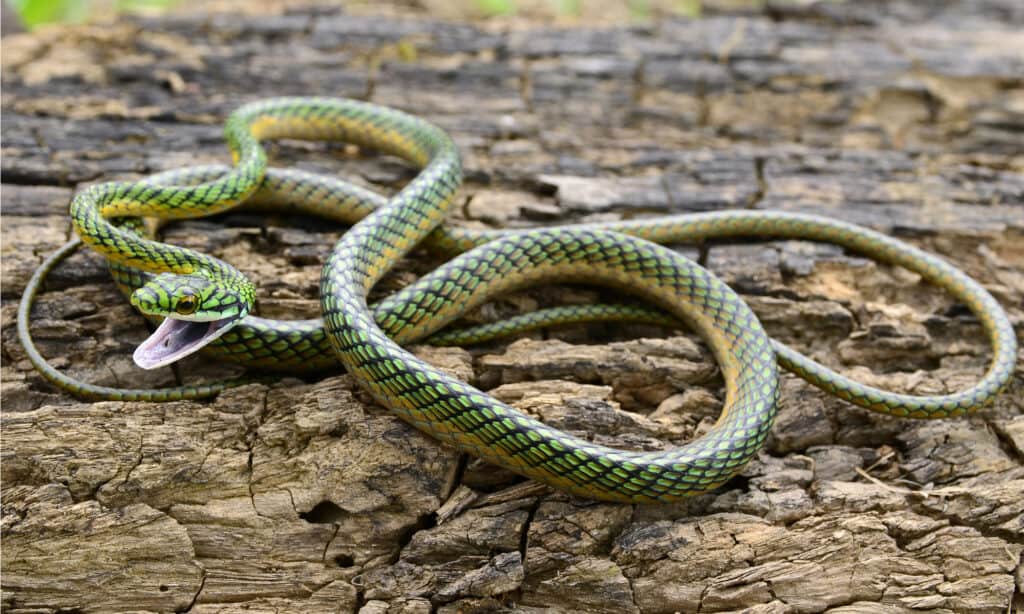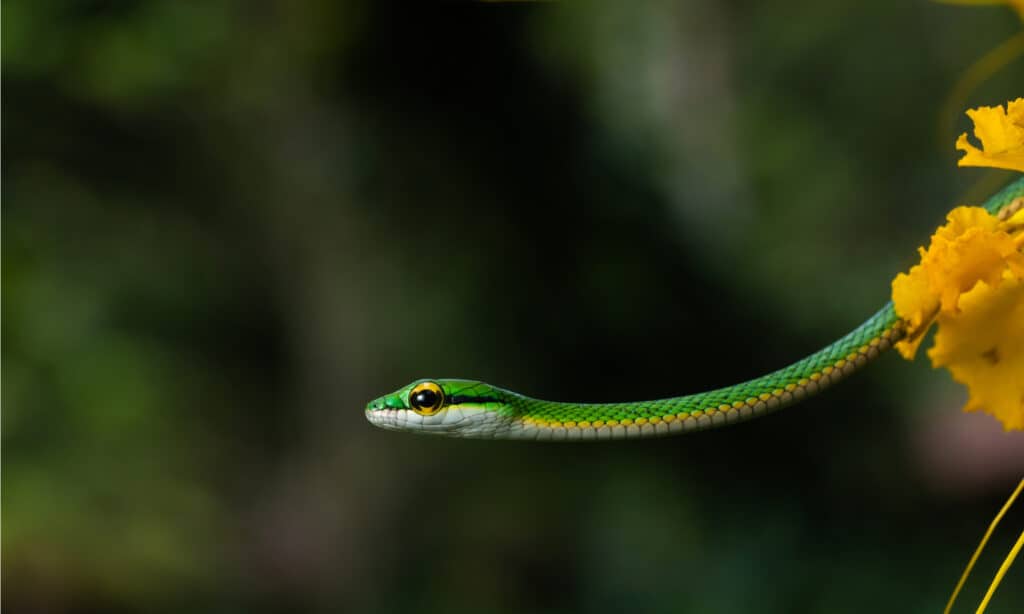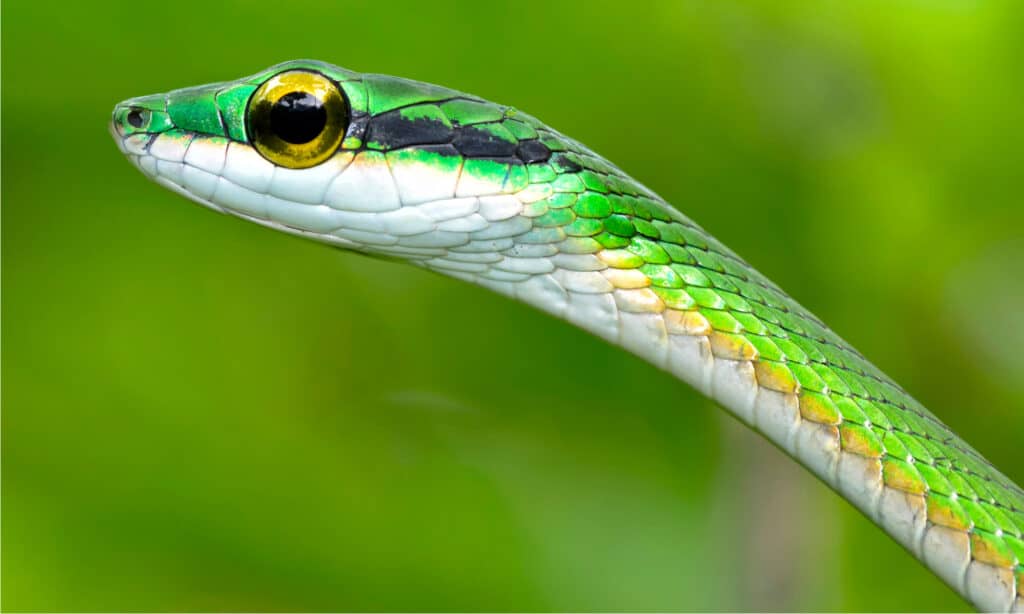Parrot Snake
Leptophis ahaetulla
The parrot snake shows off with bright green and bronze colors that cover its entire body.
Advertisement
Parrot Snake Scientific Classification
- Kingdom
- Animalia
- Phylum
- Chordata
- Class
- Reptilia
- Order
- Squamata
- Family
- Colubridae
- Genus
- Leptophis
- Scientific Name
- Leptophis ahaetulla
Read our Complete Guide to Classification of Animals.
Parrot Snake Conservation Status
Parrot Snake Facts
- Prey
- Lizards, frogs, and small birds
- Name Of Young
- Hatchlings
- Group Behavior
- Solitary
- Fun Fact
- The parrot snake shows off with bright green and bronze colors that cover its entire body.
View all of the Parrot Snake images!

The parrot snake shows off bright green and bronze colors that cover its entire body.
They are often called non-venomous snakes, but the truth is a different story. Parrot snakes have very mild venom that sometimes causes local swelling and pain. They grow extremely long and slender, slipping through the trees after their prey.
5 Amazing Parrot Snake Facts

Parrot snake
©fernandoul/Shutterstock.com
- The parrot snake is precocial, which means that it can start moving and caring for itself at birth.
- This species of slender snake is only found on land.
- Though some people have stated that the parrot snake is not venomous and is not poisonous, that is not true. Their venom is incredibly mild, and most people never need medical attention after a bite.
- There are ten subspecies of parrot snakes.
- The venom of the parrot snake is only poisonous enough to harm their prey, which is usually frogs, insects, or birds. Their venom is released for eating this prey as they hold it in place.
Evolution and Origins
Leptophis ahaetulla, which is often referred to as the lora or parrot snake, is a slender snake of medium size belonging to the Colubridae family. This snake species is found exclusively in Central America and the northern regions of South America.
Parrot snakes are typically restricted to Central America and South America, with their distribution spanning countries such as Belize, Guatemala, Nicaragua, Colombia, Peru, Uruguay, and others within this geographic region.
These snakes are particularly abundant in southern Mexico, which has led to them being colloquially referred to as Mexican snakes.
Where to Find Them

Parrot snake
©Patrick K. Campbell/Shutterstock.com
Parrot snakes tend to go no further than Central America and South America. They are often found in Belize, Guatemala, Nicaragua, Columbia, Peru, Uruguay, and other countries in this region. They thrive in southern Mexico, leading some people to refer to them as a Mexican snake.
They prefer a terrestrial habitat, which means they prefer land to sea. Their name is primarily determined by where they live.
Scientific Name

Parrot snake
©Thorsten Spoerlein/Shutterstock.com
The parrot snake, which is also known as the lora snake, has the scientific name of Leptophis ahaetulla, which is Greek in origin. “Leptophis” comes from the words “leptus” (which means “delicate” or “thin”) and “ophis” (which means “snake”).
The class of the parrot snake is Reptilia, and it is from the Colubridae family. The Mexican snake is part of the same genus, but it is not a parrot snake under this category.
The 10 Different Types

Parrot snake
©Al Carrera/Shutterstock.com
There are 10 subspecies of parrot snakes, which include:
– Leptophis ahaetulla ahaetulla
– Leptophis ahaetulla bocourti.
– Leptophis ahaetulla bolivianus
– Leptophis ahaetulla chocoensis
– Leptophis ahaetulla liocercus
– Leptophis ahaetulla marginatus
– Leptophis ahaetulla nigromarginatus
– Leptophis ahaetulla occidentalis
– Leptophis ahaetulla ortonii
– Leptophis ahaetulla praestans
Though very little is known about the differences between the species, only a few of have specific names. Leptophis ahaetulla nigromarginatus, or the black-skinned parrot snake, is only found in South America. The Mexican parrot snake, which isn’t mentioned above, isn’t actually under the parrot snake subspecies, though it is still classified as a slender snake.
Population and Conservation Status
There is no official population of parrot snakes, but the IUCN Redlist suggests that the population is stable. They do not migrate, and they are of Least Concern in conservation efforts.
How to Identify: Appearance and Description
The parrot snake is incredibly colorful. Though all of this color normally is a sign to stay away, the Lora snake is relatively harmless. The body of the parrot snake can reach up to 23 inches long, and it is decorated with bronze, gold, and bright green hues.
Along the 15 rows of mid-body dorsal scales, users will see a bold black hue. The belly and upper lip, however, are either white or yellow.
With an elongated head, their yellow eyes are hard to miss.
How to identify a Parrot Snake:
- Bright green, bronze, or gold body with a yellow or white belly.
- 15 rows of black dorsal scales.
- Narrow head with yellow eyes.
- Up to 23 inches long.
Venom: How Dangerous Are They?
The lack of harm that the venom of the parrot snake is misleading. In fact, these snakes were previously thought to be non-venomous, but that isn’t the case. Their teeth are set back further in the head, making it hard for them to open up their mouth enough to bite someone.
If you manage to get bitten, the bite will feel minimal pain at the site. The venom is mild (at best), and it gives a pins-and-needles sensation. Typically, medical attention isn’t necessary because the pain goes away after a few hours. However, if you aren’t sure if this is the snake that bit you, check in with a doctor soon.
Behavior and Humans
Though the parrot snake is an aggressive hunter, it doesn’t provide much threat to humans. Even though their bite is not strong enough to cause any real harm, it is best to leave them alone as they are incredibly agile.
View all 192 animals that start with PParrot Snake FAQs (Frequently Asked Questions)
Why is it called a parrot snake?
The name “parrot snake” is a tribute to the bright colors of this reptile.
Can a parrot snake kill you?
The venom that the parrot snake releases is not as bad as what other snakes release. They aren’t much of a risk for anyone bitten. Their bite is primarily meant for the animal they are eating, not humans. At the most, they might release a warning strike, but they aren’t dangerous for most people.
Is a parrot snake venomous?
Yes. The parrot snake releases venom when they bite. Though it is poisonous , it is extremely weak, so most humans don’t bother to seek out medical attention.
How big is a parrot snake?
Parrot snakes can grow to be almost 6 feet long, though some of them are less than two feet long at birth.
What eats a parrot snake?
These snakes are a natural part of the food chain for animals in Central America and South America, like large birds of prey and other animals. However, researchers don’t have a specific list of predators that can be found eating these snakes.
Do parrot snakes have teeth?
Yes! Though the parrot snake isn’t that dangerous, it has enlarged teeth that help it to hang onto its prey. However, since the teeth are so far back, humans aren’t at any real risk of injury.
Thank you for reading! Have some feedback for us? Contact the AZ Animals editorial team.
Sources
- , Available here: https://en.wikipedia.org/wiki/Leptophis_ahaetulla
- , Available here: https://www.braeunerd.com/not-all-snakes-are-created-equal/
- , Available here: https://eol.org/pages/1056153
- , Available here: https://animalia.bio/leptophis-ahaetulla
- , Available here: http://reptile-database.reptarium.cz/species?genus=Leptophis&species=ahaetulla

















